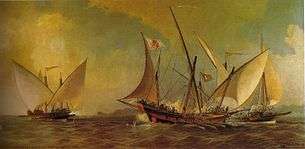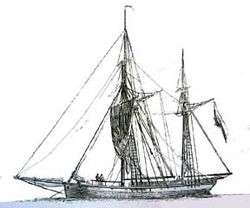Galiot

A Spanish ship (center) attacked by two Algerian galiotes (1738)

A Dutch galiot from Willaumez's Dictionnaire de la Marine in the 17th century

A galiote, or scute, transporting wine on a French river during the 18th century
A galiot, galliot or galiote, is a term for three different types of historical naval vessels that sailed on different seas, and for a type of French flat-bottom river boat or barge.
Naval vessels
- Mediterranean, (16th century–17th century)
- Historically, a galiot was a type of ship with oars, also known as a half-galley, then, from the 17th century forward, a ship with sails and oars. As used by the Barbary pirates against the Republic of Venice, a galiot had two masts and about 16 pairs of oars. Warships of the type typically carried between two and ten cannons of small caliber, and between 50 and 150 men. According to Philip Carse's The Age of Piracy (Hale, 1959), it was a Barbary galiot, captained by Barbarossa I, that captured two Papal vessels in 1504.
- North Sea (17th century–19th century)
- A galiot was a type of Dutch or German 20 to 400 GRT trade ship, similar to a ketch, with a rounded fore and aft like a fluyt. They had nearly flat bottoms to sail in shallow waters. These ships were especially favored for coastal navigation in the North Sea and Baltic Sea. To avoid excessive leeway, or leeward drift due to their flat bottoms, smaller vessels were usually fitted with leeboards. After 1830, a modernised type of galiot was developed that featured a sharper bow similar to a schooner. These vessels rarely had leeboards.[1]
- Naval ships (17th century–19th century)
- A galiote was a term for a French bomb vessel, a type of naval warship the size of a corvette based on galiot trade ships, that carried one or more cannons for shelling coastal towns.
Canal and river boats
- A galiote was a horse-drawn barge pulled along canals or rivers banks, which were popular in France from the mid-17th century through the 19th century.
- A galiote, or scute, also was a type of flat-bottomed boat with a simple sail that traveled French rivers transporting wine in the Anjou region as far as Les Ponts-de-Cé.[2]
See also
References
- ↑ Jonas, Wolfgang (1990). Nordfriesisches Schiffahrtsmuseum Husum, ed. Schiffbau in Nordfriesland [Shipbuilding in North Frisia]. Schriftenreihe des Nordfriesischen Schiffahrtsmuseums Husum (in German) 1. Husum Druck- und Verlagsgesellschaft. pp. 38–39. ISBN 3-88042-522-1.
- ↑ La Loire – les peuples du fleuve, par Abel Poitrineau. Ed. Horvath, Saint-Etienne, 1989. pp. 21–26.
External links
- Pictures of a 1738 Baltic Sea galiot model High resolution photos
| Wikimedia Commons has media related to Galiots. |
| ||||||||||||||||||||||||||||||||||||||||||||||||||||||||||||
This article is issued from Wikipedia - version of the Tuesday, August 18, 2015. The text is available under the Creative Commons Attribution/Share Alike but additional terms may apply for the media files.